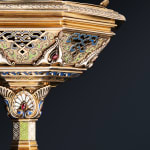Open a larger version of the following image in a popup:
 Jules Wièse - Cup and Paten, ca. 1870
Jules Wièse - Cup and Paten, ca. 1870
 Jules Wièse - Cup and Paten, ca. 1870
Jules Wièse - Cup and Paten, ca. 1870
Jules Wièse
Chalice and paten, ca. 1865
Silver-gilt, cloisonné enamel, chrysoprase, grenat
h. 8 in. (20,4 cm) - d. 12 1/3 in. (31,4 cm)
Signed with Minerva, JW monogram and WIESE
Unique piece
Unique piece
Further images
Provenance
(Chalice)
Private collection, southern France - Patrick Berna, Nice, 2000 - An important European privatecollection, acquired directly from the above dealerat the 2000 Biennale des Antiquaires in Paris, until 2023.
(Paten)
Me Issaly & Pichon, Cannes, France, 26th April 2008, lot 233 - Private collection - Hôtel des Ventes Nice Riviera SVV, Nice, France, 27th March 2011 - Galerie Neuse, Bremen, Germany, acquired at the above sale, until 2023.
Both pieces were reunited in 2023.
Exhibitions
Oscar Graf, TEFAF Maastricht 2024, "Symbolism : New Horizons"Literature
Silke Hellmuth, Jules Wièse und seine Atelier, Goldschmiedekunst des 19. - Jahrhunderts in Paris, Berlin, 2014, pages 166-167 (both chalice and paten illustrated).








